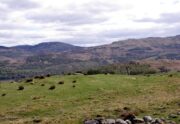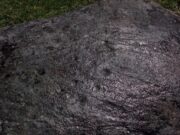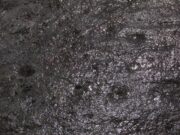Cup-Marked Stone: OS Grid Reference – NN 64795 38648

Along the A827 road between Killin and Kenmore, park at the entrance to the Tombreck track and cross the road, walking up the track heading up Ben Lawers. Pass the sheep pens, through the gate and keep going for a few hundred yards until you hit the old straight line of walling which runs off east into the pine trees a few hundred yards away. Walk along here, keeping to the south side, for less than 100 yards, watching out for a small stone on a small rise on a small hillock – and make sure your eyes are in good condition!
Archaeology & History

This is a seemingly unrecorded cup-marked stone, with very faint petroglyphic evidences just visible on the surface. Set within the wider surrounds of more recent enclosure walling, this is a small slightly raised female (rounded, smooth) stone, roughly three feet in diameter, which has at least five cup-markings on its surface—mainly near the middle of the stone. The rock itself is next to the western edge of a raised man-made feature, reminiscent of a collapsed denuded cairn or hut circle, which itself has not been archaeologically assessed. It is one of a number of petroglyphs in relative proximity to each other on the geological ridge above Loch Tay (not visible from here).


As you can see in the photos left and right, the cups are only truly visible when the stone has been wet. Initially I thought that this carving may have been one that was mentioned briefly in George Currie’s (2009) notes—at NN 64736 38647, 62 (57m) yards to the east—but it doesn’t seem to be the case as the grid reference he cited differs from this. There are going to be a number of other unrecorded carvings scattered about beneath the great shadow of Ben Lawers…
References:
- Currie, George, “Cup-and-Ring Marked Rocks,” in Discovery & Excavation, Scotland, volume 10, 2009.
Acknowledgements: Huge thanks to Paul Hornby for the use of his photos in this site profile; and to Lisa Samson, for her landscape detective work at the site.
© Paul Bennett, The Northern Antiquarian
The map could not be loaded. Please contact the site owner.